En la celebración de sus 80 años la Universidad de Caldas publica este libro sobre los pájaros que viven en los territorios de la institución, con un registro de 258 especies, un enorme patrimonio biológico que la Universidad preserva y estudia.
La Editorial Universidad de Caldas acaba de publicar un libro sobre las aves que habitan el territorio de la institución. 258 especies registradas. Un patrimonio biológico que la universidad preserva y estudia.
A continuación, un fragmento del libro.
Cantos que no cesan. Aves de la Universidad de Caldas
Editorial Universidad de Caldas, 2023.
Presentación
Colombia es un territorio rico en especies de pájaros. Hay aproximadamente 1.909 especies vivas registradas en el país, pertenecientes a 90 familias, según un conteo reciente. El departamento de Caldas es una de las zonas más ricas a este respecto, con cerca de 820 especies. Si en el mundo hay unas 10.000 especies de aves, esto significa que en Caldas habita cerca del 10% de las especies de pájaros registradas en el planeta. En el territorio específico que ocupa la Universidad de Caldas, como verán en este libro, se han registrado 258 especies. Pero éstas son sólo cifras, y las solas cifras son engañosas. En este caso nos hablan de la enorme diversidad biológica del territorio, pero deberíamos repensar nuestra relación con dicha riqueza, incluso cuestionar nuestro concepto de riqueza, puesto que podríamos estar enfrentando una extinción inusualmente grande de especies en el planeta, en buena parte debido a la conducta de las sociedades humanas.
En el año 2017 un grupo de estudiantes, egresadas y profesores de la Universidad de Caldas decidió estudiar los pájaros de la universidad: registrar las especies que aquí habitan o van de paso, aquellas que sólo viven en este territorio (las endémicas); estudiar su conducta y características; fotografiarlas y tratar de entender sus costumbres, si se nos permite el antropomorfismo. Uno de los resultados de este trabajo es este libro.
Aunque muy probablemente para los pájaros las construcciones humanas son otra parte del paisaje natural, los humanos vemos una diferencia entre lo rural y lo urbano. En este libro lectoras y lectores encontrarán aves que prefieren el campo y otras que habitan la ciudad (en este caso Manizales), compañeras salvajes incrustadas en la civilización, desentendidas de ella salvo por las numerosas fuentes de comida que encuentran por ahí. En medio de la ciudad, uno de los pocos manchones verdes de bosque que quedan es el Jardín botánico, adjunto a la sede central de la universidad: casi siete hectáreas en las que aves residentes y migratorias siguen día a día con su trajín, protegidas por el bosque del tráfago citadino que las rodea, al menos por ahora.

Además de las sedes urbanas, la universidad tiene granjas ubicadas en varios pisos térmicos, lo cual implica una mayor diversidad biológica. Está la granja Tesorito, entre los 2.100 y 2.340 metros sobre el nivel del mar, en la que los pájaros montañeros hacen su vida entre los árboles de tomate y feijoa, las matas de mora, las zanahorias, lechugas y coliflores. Otras aves ocupan los pastizales al lado de ganado bovino (o, a veces, encima de éste), y otras más viven en las pocas zonas boscosas que persisten con terquedad en las laderas.
Las granjas La Cruz y Montelindo están en una zona mucho más baja y cálida: a 950 y 1.010 metros sobre el nivel del mar. En las 64 hectáreas de Montelindo vimos pájaros volar sobre los cultivos de maíz y luego bajar para moverse a saltos entre las plantaciones de cítricos, aguacate y maracuyá, o en los pastizales junto al ganado vacuno, o en los bordes de los bamboleantes guaduales. No esperábamos encontrar tanta variedad de aves acuáticas residentes y migratorias, por lo que la inspección de los estanques y lagos artificiales estuvo llena de sorpresas. El pequeño bosque de cinco hectáreas que aún pervive en la granja La Cruz también resultó un hábitat protector para muchos pájaros, dado que este tipo de bosque ha desaparecido del cañón del río Cauca en la zona.
Registramos finalmente 258 especies de aves en los campus de la universidad, pertenecientes a 51 familias, lo que representa casi el 57% de las familias de aves registradas en Colombia. Como verán en este libro, se trata de una diversidad de color que casi agota el espectro de matices que es capaz de percibir el ojo humano y, como esperamos que puedan intuir a partir de nuestras descripciones, una variedad igualmente sorprendente de voces, ritmos y mensajes. La dieta parece preparada por un dios pagano lujurioso: desde carroña hasta peces, pasando por insectos, frutos o néctar. Los territorios de la universidad son propicios también para algunas aves viajeras: registramos 37 especies migratorias provenientes de Norteamérica y una especie proveniente del extremo sur del continente. Vale la pena mencionar el registro de los pericos Paramuno y Frentirojo, el Pibí boreal y la Reinita Cerúlea, desplazados de su hábitat por la tala de bosques y que ahora encuentran su último refugio en algún campus de la universidad.
Además del registro de las especies, estudiamos la información disponible sobre las principales características de la historia natural de estos pájaros. El resultado fue la típica descripción científica, aparentemente fría que no deja ver la verdadera pasión que sentimos quienes estudiamos las aves, aunque quizá la frialdad de que se acusa a la ciencia es el gesto apasionado de quienes estudiamos las aves porque las amamos. Aquí intervino el Laboratorio de comunicación de la universidad, y entonces un grupo de profesoras y estudiantes de filosofía y letras trabajó junto al grupo de ornitología para descifrar la conducta de los pájaros en términos humanos, antropomorfos y juguetones. Esperamos que el resultado agrade a lectoras y lectores y, sobre todo, que logre interesarlos por la gran diversidad que nos rodea y que está en riesgo, y de cuya amenaza nosotros, los humanos, hacemos parte.
Autoras y autores queremos dar los agradecimientos a la Vicerrectoría de Proyección Universitaria y a la Editorial Universidad de Caldas, en cabeza de Patricia Salazar y Luis Miguel Gallego, respectivamente, por el apoyo decidido que le dieron al proyecto. A Carlos Esteban Lara, Jorge Luis Vásquez, Juan Alejandro Morales, Camilo Llanos y Andrés López les agradecemos por sus comentarios a las primeras versiones del texto.
Presentation
Colombia is a territory rich in bird species. There are approximately 1,909 documented species in the country that belong to 90 families, according to a recent count. The department of Caldas is one of the richest areas in this regard, home to about eight hundred and twenty species. If there are about 10,000 species of birds in the world, this means that about 8% of the species recorded on the planet inhabit Caldas. Two hundred fifty eight species have been registered in the specific territory occupied by Universidad de Caldas, as you will see in this book. But these are just numbers, and numbers alone are misleading. In this case, they tell us about the enormous biological diversity of the territory, but we should rethink our relationship with said wealth –even question our conception of wealth– since we could be facing an unusually large extinction of species on the planet, largely due to the behavior of human societies.
In 2017, a group of ornithologists made up of students, graduates, and professors from the Veterinary Medicine program and the Zootechnics and Biology program decided to study the birds at Universidad de Caldas: they would register the species that inhabit or pass through here, those that only live in the Colombian territory (the endemic ones); study their behavior and characteristics, photograph them and try to understand their customs, if anthropomorphism is allowed. One of the results of this work is this book.
Although human constructions are most likely just another part of the natural landscape to birds, humans do see a difference between rural and urban. In this book, readers will find birds that prefer the countryside, and others that inhabit the city (in this case, Manizales), wild companions embedded in civilization, oblivious to it except for the numerous sources of food they find out there. In the middle of the city, one of the few green patches of forest that remain is the Botanical Garden, attached to the central campus of the University: almost seven hectares in which resident and migratory birds continue their bustle day by day, protected by the forest from the city traffic that surrounds them –at least for now.
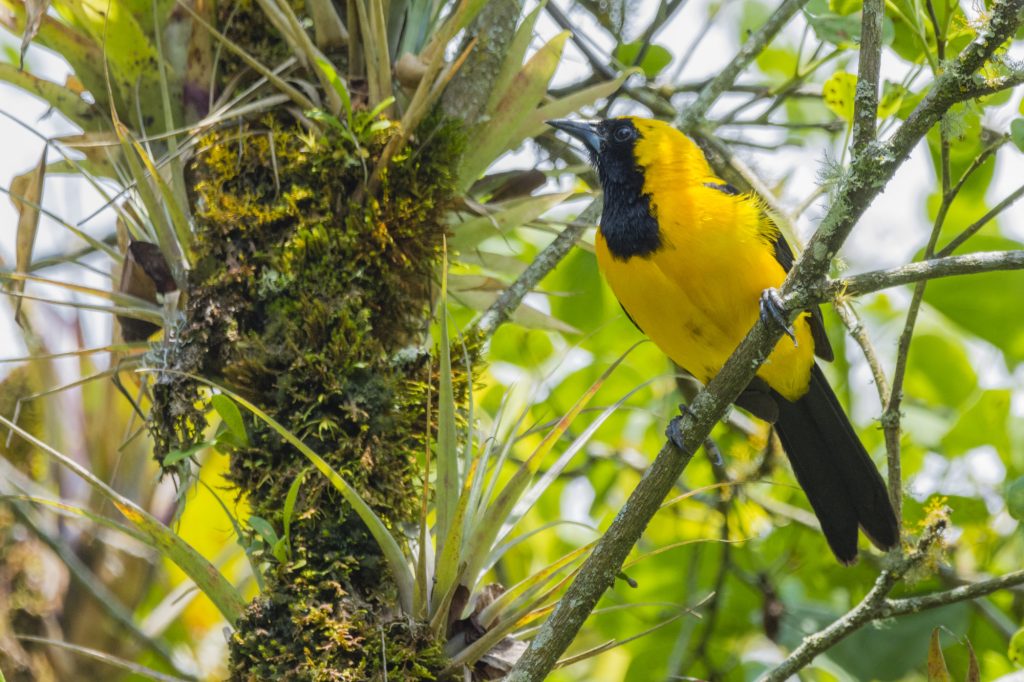
In addition to urban campuses, the University has farms located on various thermal floors. There is the Tesorito farm, between 2,100 and 2,340 meters above sea level, where mountain birds make their lives among tamarillo and feijoa shrubs, blackberry bushes, carrots, lettuce, and cauliflower. Other birds occupy the grasslands next to (or sometimes on top of) cattle, and still others live in the few wooded areas that stubbornly persist on the slopes.
The La Cruz and Montelindo farms are in a much lower and warmer area: 950 and 1,010 meters above sea level. In the 64 hectares of Montelindo, we saw birds fly over the corn crops, then descend to their landing in leaps between the citrus, avocado, and passion fruit plantations, on the pastures next to the cattle and the edges of swaying guaduales (bamboo fields). We did not expect to find such a variety of resident and migratory waterfowl, so our inspection of the fishponds and artificial lakes was full of surprises. The small five-hectare forest that still survives on La Cruz farm was also a refuge for many birds that inhabit the deforested canyon of the Cauca River.
We finally registered 258 species of birds on the university campuses, which belong to 51 families. This richness represents almost 57% of the bird families registered in Colombia. As you will see in this book, there is such diversity in color here that it almost exceeds the spectrum of hues that the human eye can perceive and, as we hope you can gather from our descriptions, an equally surprising variety of voices, rhythms, and messages. The diet seems prepared by a lustful pagan god: carrion, fish, insects, fruit, and nectar. The University’s territories are also suitable for some traveling birds: we registered 37 migratory species from North America and one species from the extreme south of the continent. It is worth mentioning that the Golden-plumed and the Scarlet-fronted Parakeets, displaced from their habitat by the clearing of forests, have found their last refuge on one of the campuses.
In addition to the species registry, we studied the information available on the main characteristics of the natural history of these birds. The result was the typical scientific description, seemingly cold, that does not reveal the true passion that those of us who study birds feel. Although, perhaps, the coldness that we accuse science of is the passionate gesture of those of us who study birds because we love them. This is where the University Communication Laboratory intervened, and a group of professors and students of Philosophy and Letters worked together with a group of ornithologists to decipher the behavior of birds in human, anthropomorphic, and playful terms. We hope that the result will please the readers and, above all, that it will manage to interest them because of the great diversity that surrounds us, which is at risk. We, humans, are part of the threat that creates that risk.
The authors wish to thank the Vicerrectoría de Proyección Universitaria and Editorial Universidad de Caldas, led by Patricia Salazar and Luis Miguel Gallego, respectively, for the determined support they gave to the project. We thank Carlos Esteban Lara, Jorge Luis Vásquez, Juan Alejandro Morales, Camilo Andrés Llano and Andrés Mauricio López for their comments on the early versions of the text.
ALCEDINIDAE (Martines pescadores – Kingfishers)
Los Martín Pescadores del Nuevo mundo podrían ser considerados como los francotiradores acuáticos de la armada de las aves, aunque ellos mismos son también el proyectil. Son aves extraordinarias, hidrodinámicas, dotadas con herramientas especiales que los convierten en perfectos cazadores-pescadores, cuya lista de objetivos se compone casi completamente de peces. Su técnica de pesca consiste en atravesar el agua, atrapar la presa con su largo pico, reducir su velocidad drásticamente y luego, de manera retráctil, escapar volando como un dios pagano.
Desde perchas localizadas alrededor de los estanques piscícolas de la Granja Montelindo se zambullen los martines pescadores Grande (Megaceryle torquata), Matraquero (Chloroceryle amazona) y Chico (Chloroceryle americana) para atrapar con sus picos peces de diversos tamaños. El plumaje verde predomina en los martines pescadores Matraquero y Chico, en los cuales, además, los machos visten un pectoral rojo que los diferencia de las hembras.
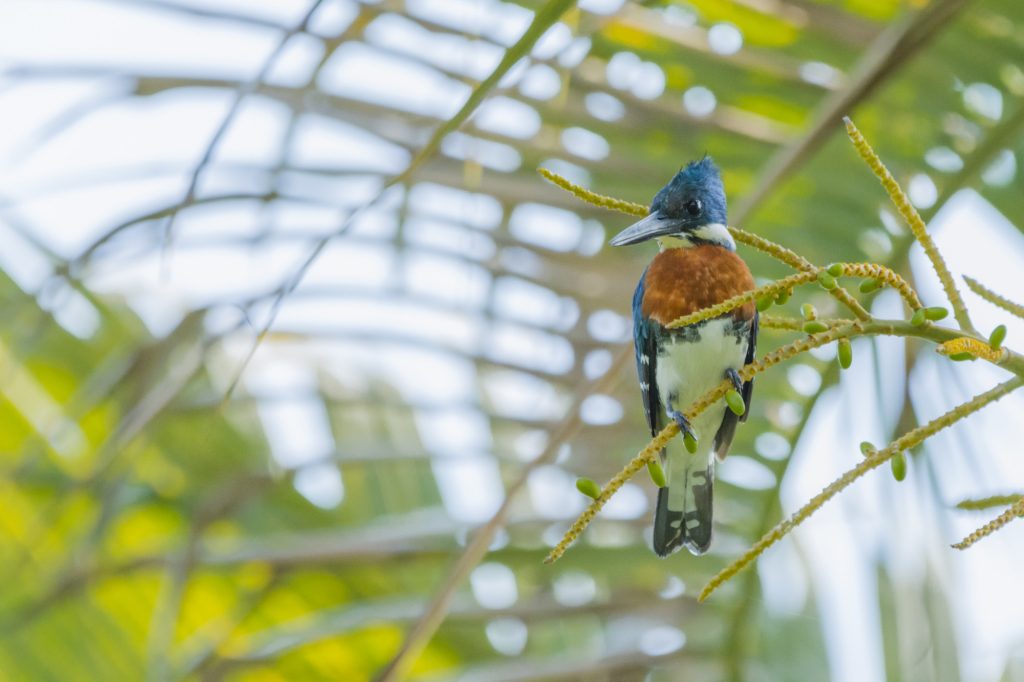
ALCEDINIDAE (Martines pescadores – Kingfishers)
The kingfishers of the New World could be considered the aquatic snipers of the bird armada, although they are also the projectile. They are extraordinary, hydrodynamic birds, endowed with special tools that make them perfect hunter-fishermen, whose target list is made up almost entirely of fish. Their fishing technique involves flying through the water, catching their prey with the long beaks, drastically slowing down, and then flying away like pagan gods.
The Ringed (Megaceryle torquata), the Amazon (Chloroceryle amazona), and the Green (Chloroceryle americana) Kingfishers dive from perches located around the fishponds of the Montelindo Farm to catch fish of various sizes with their beaks. The green plumage predominates in the Amazon and Green Kingfishers, whose males, in addition, wear a red pectoral that differentiates them from the females.
ANATIDAE (Patos – Ducks)
Hay patos en las Islas Kerguelen, las Islas de la Desolación, como se les conocía hasta hace un tiempo, más cerca de la Antártida que de África; hay patos en las aguas heladas del océano ártico y hay patos en casi todo el planeta. Comen principalmente material vegetal –en menor medida invertebrados—, y pasan una parte importante de su tiempo en el agua. Nos parecen torpes al caminar, son buenos buceando y expertos en el vuelo. La mayoría se reúne en grupos pequeños o en bandadas (son gregarios). Cuando vuelan, las bandadas más grandes pueden verse a lo lejos tan densas como si fueran enjambres.
En la Granja Montelindo se puede encontrar al Pato Pisingo (Dendrocygna autumnalis). Se alimenta de hojas, raíces, bulbos y frutos en las aguas poco profundas y en los bordes de los estanques de peces. A diferencia de otros patos, el Pisingo no se expresa con el típico parpeo (ese “cuac, cuac”), sino que silba, en especial cuando vuela. Durante la época reproductiva ambos padres participan activamente en la incubación de los huevos, la defensa del nido y el cuidado de las crías.

ANATIDAE (Patos – Ducks)
There are ducks on the Kerguelen Islands –or the Desolation Islands, as they were known until a while ago– that are closer to Antarctica than to Africa; there are ducks in the frozen waters of the Arctic Ocean, and there are ducks almost everywhere on the planet. They eat mainly plant material –to a lesser extent, invertebrates– and spend a significant part of their time in the water. We find their walk clumsy, but they are good at diving and experts when it comes to flying. Most gather in small groups or flocks (they are gregarious). When they fly, the largest flocks can be seen in the distance as dense as if they were swarms.
At the Montelindo Farm, you can find the Black-bellied Whistling-Duck (Dendrocygna autumnalis). It feeds on leaves, roots, bulbs, and fruits found in shallow waters and at the edges of fishponds. Unlike other ducks, the Black-bellied Whistling-Duck does not only quack, but he also whistles, especially when flying. During the reproductive season, both parents actively participate in the incubation of the eggs, nest´s defense, and the care of the chicks.
COTINGIDAE (Fruteros – Fruiteaters)
La mayoría de las contingas se alimentan de frutos que buscan desde las copas de los árboles hasta el sotobosque: esa zona intermedia entre la vida y la muerte, donde todo se pudre y resucita en las formas impredecibles de la vida. Los machos de algunas de las especies despliegan su gracia en sofisticadas sesiones de cortejo, donde producen su canto típico y exhiben arrogantemente, a modo de danza carnavalesca, ese plumaje brillante atravesado por todos los matices de color en un fulgor que el sol gobierna. Las exhibiciones de cortejo rememoran las vistosas, ruidosas y eufóricas fiestas populares, que al fin al cabo tambien tienen por objeto atraer pareja.
En los estratos medios de los bosques de la granja Tesorito vive el Frutero Verdinegro (Pipreola riefferii): pájaro silencioso y poco visible, pero los colores rojo naranja del pico y patas pueden delatar su presencia entre las ramas. Comen principalmente bayas o todo fruto que se le parezca a éstas, que recogen incansablemente, bien sea posados en una rama o al vuelo.
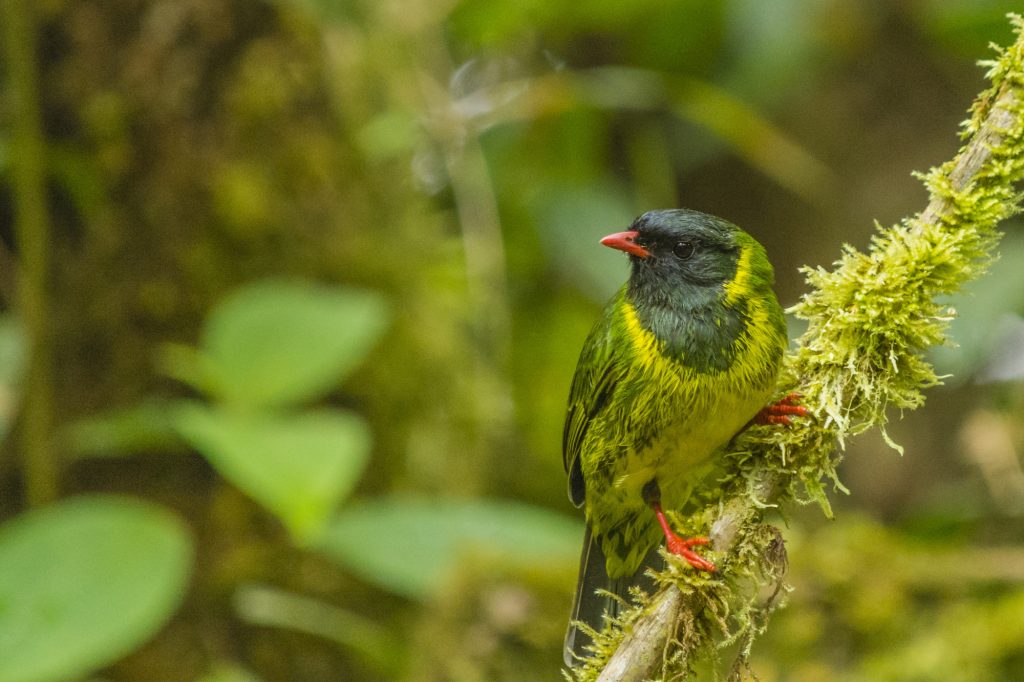
COTINGIDAE (Fruteros – Fruiteaters)
Most of the fruiteaters feed on fruits that they search from the treetops to the understory: that intermediate zone between life and death, where everything rots and resuscitates in the unpredictable forms of life. The males of some of the species display their grace in sophisticated courtship sessions. They produce their typical song and arrogantly display, like a carnival dance, that brilliant plumage pierced by all shades of color in a radiance ruled by the sun. The courtship displays recall the colorful, noisy, and euphoric popular festivals, which in the end are also intended to attract a partner.
In the middle strata of the forests of the Tesorito farm lives the Green-and-black Fruiteater (Pipreola riefferii): a silent and inconspicuous bird, but the orange-red colors of the beak and legs can betray its presence among the branches. It eats mainly berries or any fruit that resembles these, which they tirelessly gather, either perched on a branch or in flight.
TROCHILIDAE (Colibríes – Hummingbirds)
Cuando los españoles llegaron a descubrir lo que los pueblos amerindios habían ya conocido mucho antes no estaban preparados para encontrarse con los colibriés. Al verse sin palabras para nombrar tales fantásticos seres, supusieron que se trataba de abejas enormes o de algún otro insecto zumbador que bebía de las flores. El zumbido que hacen al volar es muy llamativo, tanto, que en el inglés actual su nombre recuerda al de un motor o máquina que zumba. Al observarlos detenidamente, los conquistadores notaron que se trataba de pequeños pájaros, y varios cronistas de Indias cuentan que empezaron a llamarlos tominejos, porque pesaban menos de una onza o tomín. Antes de la llegada de los españoles, las culturas ancestrales representaron al colibrí en numerosos papeles: los mexicas le llamaban huitsitsili, guerreros, de donde viene el nombre del dios Huitzilopotchli, luchador por excelencia. En Perú les decían espadas de los Andes, quizá porque su belleza contrasta con su carácter belicoso: a veces luchan como esgrimistas con sus largos picos, algunos son muy territoriales, y cuando su vistoso plumaje no es suficiente apelan al ruido y la fantochada para espantar a sus contrincantes. Un ejemplo es el Colibrí Chillón (Colibri coruscans), que se percha en lugares elevados, realizando vocalizaciones constantes y vuelos cortos, para disuadir a otros piratas robaflores. Por el contrario, los ermitaños Verde (Phaethornis guy) y Leonado (Phaethornis syrmatophorus) no defienden un territorio, se mueven a través del bosque recorriendo una serie de rutas relativamente establecidas en las que visitan flores ricas en néctar. Estos cupidos de la naturaleza, al ir de flor en flor, ayudan a la polinización, y esto los hace vitales para el ecosistema.
No es extraño que a los colibríes se les compare con gemas voladoras: “Pájaro de pedrería o fina joya con alas”, les llamó el poeta Althaus. Tanto en los mitos como en la clasificación científica se hace alusión a su parecido con piedras preciosas, tal es el caso del colibrí Esmeralda Occidental (Chlorostilbon melanorhynchus). En algunas especies la hembra y el macho exhiben de manera ostentosa atavíos diferentes en su plumaje, que permiten diferenciarlos. En el colibrí Nuquiblanco (Florisuga mellivora) el macho descresta por el plumaje zafiro en su cabeza; en el Buffon (Chalybura buffonii) el verde esmeralda en el pecho del macho. Así mismo, en el macho del Mango Pechinegro (Anthracothorax nigricollis) la garganta y pecho se asemejan a las variedades verdosas del ónice, aunque con muchos más matices de colores vivos; y en el Rumbito Buchiblanco (Chaetocercus mulsant), la garganta del macho –violeta rojiza iridiscente, como si portara un rubí— lo diferencia claramente de la hembra.
En los campus de la universidad se puede disfrutar del verde centellante del Amazilia Coliazul (Amazilia saucerottei); de las prominentes plumas violeta iridiscente a manera de “orejas” de los colibríes Chillón y Verdemar (Colibri thalassinus); del extraordinariamente largo y decurvado pico del Ermitaño Verde; y de la belleza sin igual que nos ofrece el vuelo rápido y temerario de los amazilias Andina (Amazilia franciae) y Colirrufa (Amazilia tzacatl).
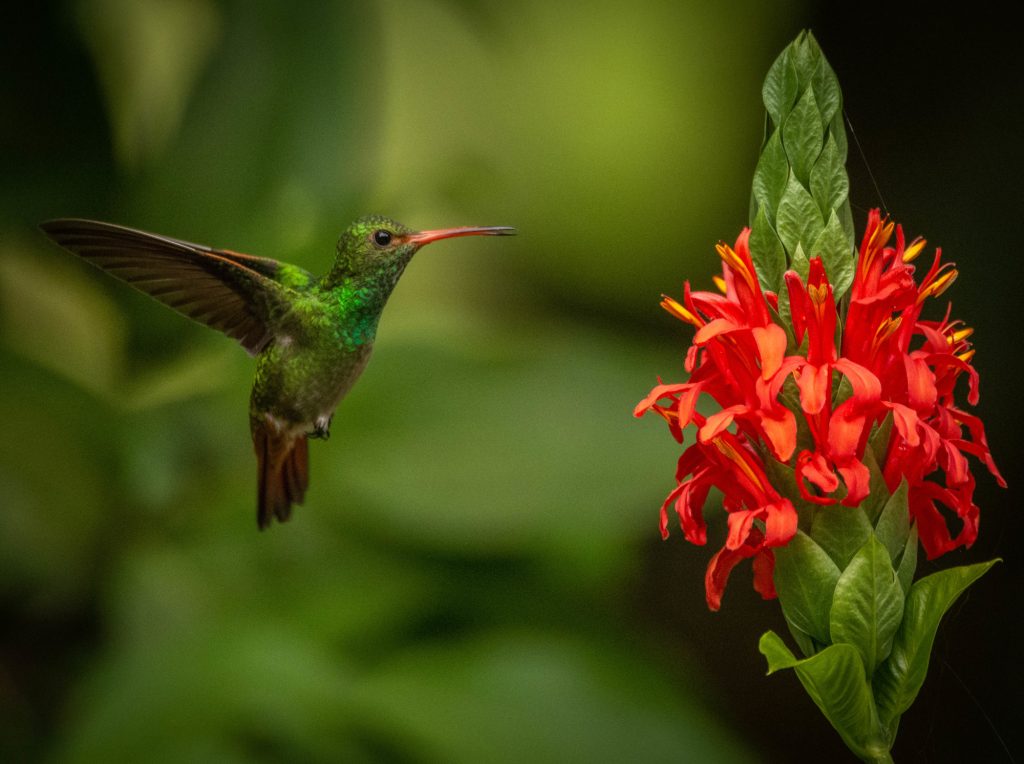
TROCHILIDAE (Colibríes – Hummingbirds)
When the Spanish came to discover what the Amerindian peoples had already known long before, they were not prepared to encounter hummingbirds. Finding themselves at a loss for words to name such fantastic beings, they guessed that they were huge bees or some other buzzing insects that drank from flowers. The buzz they make when flying is very striking, so much so that in today’s English its name is reminiscent of a buzzing engine or machine. When observing them carefully, the conquerors noticed that they were small birds. Several chroniclers of the Indies say that they began to call them tominejos, because they weighed less than an ounce or tomín. Before the Spaniards´ arrival, ancestral cultures represented the hummingbird in numerous roles: the Mexica called it huitsitsili, warriors, hence the name of the god Huitzilopotchli, a fighter par excellence. In Peru they were called swords of the Andes, perhaps because their beauty contrasts with their bellicose character: sometimes they fight like fencers with their long beaks, some are very territorial, and when their showy plumage is not enough, they appeal to noise and bragging to scare their opponents. An example is the Sparkling Violetear (Colibri coruscans), which perches in high places, making constant vocalizations and short flights to deter other flower-robbing pirates. In contrast, the Green (Phaethornis guy) and the Tawny-bellied (Phaethornis syrmatophorus) hermits do not defend a territory, they move through the forest traveling a series of relatively established routes in which they visit nectar-rich flowers. These cupids of nature, who go from flower to flower, help pollination. That is why they are vital to the ecosystem.
It is not strange that hummingbirds are compared to flying gems: “Bird of gemstones or fine jewel with wings”, the poet Althaus called them. Both in myths and in scientific classification, allusions are made to their resemblance to precious stones. Such is the case of the Western Emerald (Chlorostilbon melanorhynchus). In some species, the female and the male pretentiously display different attires in their plumage, which allow them to be differentiated. The male White-necked Jacobin (Florisuga mellivora) stands out for the sapphire plumage on its head; the male White-vented Plumeleteer (Chalybura buffonii) stands out because of the emerald green on its chest. Also, the throat and chest of the male Black-throated Mango (Anthracothorax nigricollis) resemble the greenish varieties of onyx, although it has many more shades of bright colors; and the throat of the male White-bellied Woodstar (Chaetocercus mulsant), –which is iridescent reddish violet, as if it were wearing a ruby– clearly differentiates it from the female.
On the university campuses you can enjoy the sparkling green of the Steely-vented Hummingbird (Amazilia saucerottei), the prominent iridescent violet “ear” feathers of the Sparkling (Colibri coruscans) and the Green Violetear (Colibri thalassinus) hummingbirds, the extraordinarily long and curved beak of the Green Hermit (Phaethornis guy), and the unparalleled beauty offered by the fast and reckless flight of the Blue-chested (Amazilia franciae) and the Rufous-tailed (Amazilia tzacatl) Hummingbirds.
CRÉDITOS
Textos
Germán Gómez Londoño (profesor, Departamento de Producción Agropecuaria)
Grupo de Investigación Genética, Biodiversidad y Manejo de Ecosistemas
Gabriel Jaime Castaño-Villa (profesor, Departamento de Desarrollo Rural y Recursos Naturales)
Johnathan Alvarez-Londoño (Biólogo)
Mateo Ortíz-Giraldo (Biólogo)
William David Tobón-Escobar (Biólogo)
Juan Felipe Betancurt-Grisales (Biólogo)
Santiago Andrés Ramos-Valencia (Biólogo)
Ana María Busi Quijano (MSc. Ciencias Biológicas)
Angela Maria Vargas-Daza (Bióloga)
Estefani Tatiana Martínez-Sánchez (MSc. Ciencias Biológicas)
Leydy Johana Cardona-Salazar (Bióloga)
Marelid Cardona-Romero (MSc. Ciencias Biológicas)
Mauricio Bohada-Murillo (Biólogo)
Yeny Alexandra Benavides-Ossa (Bióloga)
Grupo de investigación Tántalo, Laboratorio de comunicación
Sergio Aguirre Rudas (Profesional en Filosofía y Letras)
Juan David Giraldo Palacio (Profesional en Filosofía y Letras)
Sofía Acevedo Henao (estudiante, Profesional en Filosofía y Letras)
Daniel Felipe Montoya Ballesteros (Profesional en Filosofía y Letras)
Juan Diego Vargas Ospina (Profesional en Filosofía y Letras)
Diana Milena Múnera Rodríguez (estudiante, Profesional en Filosofía y Letras)
Marcela Castillo Villegas (profesora, Departamento de Filosofía)
Pablo Rolando Arango (profesor, Departamento de Filosofía)
Fotógrafos
Daniel Moreno López
Edwin Andrés Herrera Buitrago
Gabriel Jaime Castaño-Villa
Ana María Busi Quijano
Germán Gómez Londoño
Mauricio Bohada-Murillo
Ramiro Ramírez Cardona
Juan Felipe Betancurt-Grisales
Juan Carlos Marín Marmolejo
Santiago Andrés Ramos-Valencia
Marelid Cardona-Romero
Yinna Paola Rendón Aránzazu
Traducción al inglés por Marco Giraldo Barreto (revisada por Camila Arango Hoyos)
